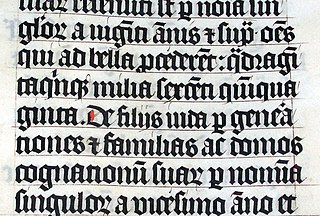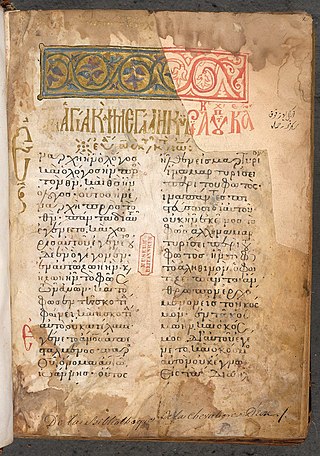Related Research Articles
An abbreviation is a shortened form of a word or phrase, by any method. It may consist of a group of letters or words taken from the full version of the word or phrase; for example, the word abbreviation itself can be abbreviated as abbr., abbrv., or abbrev.. It may also consist of initials only, a mixture of initials and words, or words or letters representing words in another language. Some types of abbreviations are acronyms or grammatical contractions or crasis.

The Masoretic Text is the authoritative Hebrew and Aramaic text of the 24 books of the Hebrew Bible (Tanakh) in Rabbinic Judaism. The Masoretic Text defines the Jewish canon and its precise letter-text, with its vocalization and accentuation known as the mas'sora. Referring to the Masoretic Text, masorah specifically means the diacritic markings of the text of the Jewish scriptures and the concise marginal notes in manuscripts of the Tanakh which note textual details, usually about the precise spelling of words. It was primarily copied, edited, and distributed by a group of Jews known as the Masoretes between the 7th and 10th centuries of the Common Era (CE). The oldest known complete copy, the Leningrad Codex, dates from the early 11th century CE.

Textual criticism is a branch of textual scholarship, philology, and literary criticism that is concerned with the identification of textual variants, or different versions, of either manuscripts (mss) or of printed books. Such texts may range in dates from the earliest writing in cuneiform, impressed on clay, for example, to multiple unpublished versions of a 21st-century author's work. Historically, scribes who were paid to copy documents may have been literate, but many were simply copyists, mimicking the shapes of letters without necessarily understanding what they meant. This means that unintentional alterations were common when copying manuscripts by hand. Intentional alterations may have been made as well, for example, the censoring of printed work for political, religious or cultural reasons.
Spelling is a set of conventions for written language regarding how graphemes should correspond to the sounds of spoken language. Spelling is one of the elements of orthography, and highly standardized spelling is a prescriptive element.

The zero-width non-joiner () is a non-printing character used in the computerization of writing systems that make use of ligatures. When placed between two characters that would otherwise be connected into a ligature, a ZWNJ causes them to be printed in their final and initial forms, respectively. This is also an effect of a space character, but a ZWNJ is used when it is desirable to keep the characters closer together or to connect a word with its morpheme.

A typographical error, also called a misprint, is a mistake made in the typing of printed or electronic material. Historically, this referred to mistakes in manual typesetting. Technically, the term includes errors due to mechanical failure or slips of the hand or finger, but excludes errors of ignorance, such as spelling errors, or changing and misuse of words such as "than" and "then". Before the arrival of printing, the copyist's mistake or scribal error was the equivalent for manuscripts. Most typos involve simple duplication, omission, transposition, or substitution of a small number of characters.

Scribal abbreviations or sigla are abbreviations used by ancient and medieval scribes writing in various languages, including Latin, Greek, Old English and Old Norse.
Dittography is the accidental, erroneous act of repeating a letter, word, phrase or combination of letters by a scribe or copyist. The term is used in the field of textual criticism. The opposite phenomenon, in which a copyist omits text by skipping from a word or phrase to a similar word or phrase further on, is known as haplography.
Spelling suggestion is a feature of many computer software applications used to suggest plausible replacements for words that are likely to have been misspelled.
A biblical manuscript is any handwritten copy of a portion of the text of the Bible. Biblical manuscripts vary in size from tiny scrolls containing individual verses of the Jewish scriptures to huge polyglot codices containing both the Hebrew Bible (Tanakh) and the New Testament, as well as extracanonical works.
"They have pierced my hands and my feet", or "They pierced my hands and my feet" is a phrase that occurs in some English translations of Psalm 22:16.

Codex Cyprius, designated by Ke or 017, ε71, or Codex Colbertinus 5149, is a Greek uncial manuscript of the four Gospels, written on parchment. It is one of the few uncial manuscripts with the complete text of the four Gospels, and it is one of the more important late uncial manuscripts. It was brought from Cyprus to Paris.

Minuscule 13, ε 368, is a Greek minuscule manuscript of the New Testament, containing the four Gospels. Using the study of comparative writing styles (palaeography), it has been dated to the 13th century. The manuscript has some missing pages. The text of the manuscript is important for New Testament textual criticism. It has several marginalia, and was adapted for liturgical use.

Minuscule 700, ε 133, is a Greek New Testament minuscule manuscript of the Gospels, written on parchment. It was formerly labelled as 604 in all New Testament manuscript lists, however textual critic Caspar René Gregory gave it the number 700. Using the study of comparative writing styles (palaeography), it has been dated to the 11th century. It is currently housed at the British Library in London.
Commonly misspelled English words are words that are often unintentionally misspelled in general writing.

Lectionary 184, designated by siglum ℓ184 is a Greek New Testament manuscript written on parchment. Textual critics Westcott and Hort referred to it by the siglum 39e, textual critic Scrivener by 259e. It is dated by a colophon to the year 1319. It is currently housed at the British Library in London.

Minuscule 482, ε 1017, is a Greek minuscule manuscript of the New Testament, on parchment. It is dated by a colophon to the year 1285 . Scrivener labelled it by number 570. The manuscript has complex context, but faded in parts. The text exhibits more numerous and bolder textual variants than usual manuscripts of the four Gospels. Marginal apparatus is given fully.

Minuscule 543, ε 257 and labelled 556 by biblical scholar and textual critic F. H. A. Scrivener, is a Greek minuscule manuscript of the New Testament, written on parchment. Using the study of comparative handwriting styles (palaeography) it has been assigned to the 12th century.
In orthography, a plene scriptum is a word containing an additional letter, usually one which is superfluous – not normally written in that word – nor needed for the proper comprehension of the word. Today, the term applies mostly to sacred scripture.

Paleo-Hebrew Leviticus Scroll, known also as 11QpaleoLev, is an ancient text preserved in one of the Qumran group of caves, and which provides a rare glimpse of the script used formerly by the Israelites in writing Torah scrolls during pre-exilic history. The fragmentary remains of the Torah scroll is written in the Paleo-Hebrew script and was found stashed away in cave no. 11 at Qumran, showing a portion of Leviticus. The scroll is thought to have been penned by the scribe between the late 2nd century BCE to early 1st century BCE, while others place its writing in the 1st century CE.
References
- ↑ This usage can be seen at Freedman, David Noel; Overton, Shawna Dolansky (2002). "Omitting the omissions: the case for haplography in the transmission of the biblical texts". In Gunn, David M.; McNutt, Paula M. (eds.). "Imagining" Biblical Worlds: studies in spatial, social and historical constructs in honor of James W. Flanagan. Journal for the Study of the Old Testament Supplement Series. Vol. 359. London: Sheffield Academic. pp. 99–116. ISBN 0-8264-6149-2.